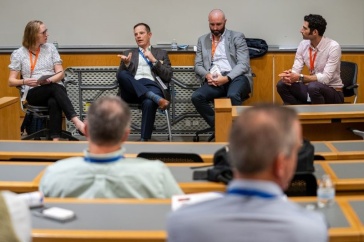Eric Harris and Dylan Klebold never quite fit in. At Columbine High School in Littleton, Colo., where athletes were worshipped and just about everyone played a sport, the two preferred violent computer games and firearms. On April 20, 1999, Harris and Klebold went on a rampage, killing 13, including themselves, and shocking the nation and the world. Afterward, when investigators reported that cliques and harassment were rampant at Columbine, the media jumped on the idea that bullying played a major role in the tragedy.
Nine years later, with more perspective, many experts have concluded that bullying was only one of many explosive factors contributing to the Columbine tragedy and other high-profile school shootings that followed. But tragedies like this one have brought bullying into the mainstream of public thought as an issue worthy of study and attention. Instead of a rite of passage, or something many children endure as a normal part of childhood, bullying is beginning to be recognized by parents and school officials as a serious problem with long-term effects.
UNH's nationally recognized Crimes Against Children Research Center has been studying bullying for 15 years, and researchers there think the public attention is overdue.

"The way we minimize the hitting and taunting of children is unfortunate," says sociology professor David Finkelhor '78G, CCRC director. "People dismiss their suffering in a way that we would never do with adults, thinking somehow that kids are more resilient, that the experience is educational or character building, or that it's a 'fight,' not an assault."
Victimized kids find nothing positive in the experience. Schoolwork tends to suffer and relationships with peers can be permanently damaged. And studies show that although many bullies are equal-opportunity victimizers, others have a knack for zeroing in on younger children or those already dealing with challenges such as anxiety or learning disabilities.
Part of the challenge in effectively addressing bullying is recognizing the difference between youthful high spirits and damaging aggression. "Children often push, shove, bump, tease, and otherwise aggravate each other," writes Todd DeMitchell, a UNH professor of education, in his 2006 book, Negligence: What Principals Need to Know about Avoiding Liability. But students who are just testing their boundaries stop when asked to and often apologize spontaneously for inadvertently hurting someone. Bullies, on the other hand, don't act in jest. They tend to plan their taunts, teasing or physical abuse and repeat their tactics over and over, deliberately trying to harm their victim.
Edward Caron '06 was bullied by the same group of boys from second grade through sophomore year in high school--simply because he looked younger than his peers. Eventually he had the courage to let the resident bullies know he found some of their antics obnoxious--especially the "Your mom..." jokes that were the rage at the time. But the verbal taunting escalated to beatings. "It pushed me to a breaking point," says Caron, "and one day I got into my first fight."
Another challenge in understanding bullying and how to prevent it is that cause and effect tend to run in a muddled but vicious circle. "Depression, anxiety, and low self-esteem are common in bullied children," says Finkelhor. Most people tend to assume that these characteristics are the result of bullying, but he notes these conditions may predate the bullying and may make a child more likely to be victimized. Although not an excuse for picking on vulnerable children, this paradox can produce a cycle that is hard to break—and its effects can be lasting. A well-regarded 1995 study indicated that by age 23, chronically victimized individuals often had lower self-esteem and were more depressed than others their age.
Rich Huss '76 was one of the plump kids in junior high school. Other students were always teasing him, trying to goad him into fighting. "It was very unpleasant," he remembers. "I wasn't very self-confident and I was always outnumbered. "It wasn't until Huss reached high school and matured into a football and track standout that the taunting ended. Huss's story reflects the research. Finkelhor says that bullying tends to start in elementary school and peak during the middle school years. In some cases, like Huss's, there's a happy ending to the story: the child matures and finds his footing, the bullies grow up or go away, and time brings with it a natural healing process.

Students at Westford Academy, a public school in Westford, Mass., have a different experience than Caron or Huss did, according to Betsy Murphy '89, a guidance counselor at the school. Westford's zero-tolerance policy on bullying is strictly enforced, she says. When an incident does occur, "we put a stop to it," she adds, whether it takes place in a classroom or on an online social networking site like Facebook or MySpace. And everyone at Westford—teachers, coaches, lunch ladies, and custodians—understands the school's policy and works together to stop bullying so that it never escalates to fistfight. Children who enter Westford Academy after years of being bullied in elementary and middle school find an alternative education program available to support their recovery. "We offer a social and academic replacement environment for the ostracized," says Murphy's colleague, Frank Grace, who teaches in the program.
This is precisely the approach educators need to take, says Finkelhor, to help stop the tricky cycle of intimidation. Establishing a school safety plan ensures that students know where to turn if bullying threatens to escalate beyond their control. And educators should check in with children on a regular basis to see if there are problems that need attention.
Today, more attention is being paid to preventing bullying, Finkelhor says, and changing attitudes are helping to fuel progress in tackling the issue. Fewer parents, for example, see bullying as a rite of passage—something they went through and now their children must, too. "In many families, the psychological well-being of the children has become more important," he says.
The problem of sibling bullying is also attracting attention. "Danielle" (name has been changed), who graduated in 1976, knows only too well the painful results of long-term sibling bullying. Her older brothers tormented her for years. Their tactics included relentless name-calling and commentary on her "ugliness and stupidity." Recovering from the bullying, which eventually included threats of physical violence, took years of therapy for which she was further ridiculed. "It was just more proof of my stupidity, weakness, and my inability to understand that everything that happened was just 'a joke,'" she says. Only recently was Danielle able to discuss her siblings' behavior with her parents, who indicated that in retrospect, they wished they had been more aware of what was happening and had intervened.
A UNH study of more than 2,000 children and caregivers nationwide found that 35 percent of the children had been "hit or attacked" by siblings in the previous year, compared with 20 percent reporting attacks by peers. When bullying comes at the hands of an older siblingâ—the very brother or sister the victim wants to look up to—it is all the more emotionally devastating, says Finkelhor, who was the lead author on the study. And while peer bullying can be occasional or short-lived, sibling bullying is often chronic.
Whatever the source of the victimization, it's important to remember that bullies, too, need understanding and help if we are going to change their behavior, he says. Some bullies see themselves as airing grievances because of lack of respect. "Bullies need to feel that their needs do matter and need to be shown what to do so that they feel respected and can get what they need without resorting to violence," he adds. "Rehearsals and role-playing about how to handle various kinds of conflicts can help." He also suggests open discussions about earning and giving respect, and emphasizes the need to give children skills to negotiate with each other when there are disagreements.
Parents of a bullying youngster need to put embarrassment aside and get help as soon as possible. In some cases, they may need assistance with parenting skills, especially if communication has broken down and they are resorting to yelling or maltreatment in an attempt to change a child's behavior. Substituting positive reinforcement and incentives, while making the consequences for misbehavior clear, can be much more effective, says Finkelhor. In some cases, a Parent-Child Interaction Therapy program or a similar resource that helps parents become more effective in managing their children's behavior can be useful.
Early intervention may have long-term benefits, keeping would-be bullies from becoming part of a sobering statistic. "Research is clear that kids who bully in school tend to end up with problems later in life," says Finkelhor. At least one study conducted in the late '80s in the United States indicated that school bullies had a one in four chance of having a criminal record by age 30. But, he cautions, studies have not yet shown whether bullying is a cause or an indicator of those problems.

Children who survive childhood bullying are, themselves, helping in a small way to turn the tide on the issue. UNH alums Huss and Caron both carried their experiences with them, a common tendency when bullying has been long-standing. In the end, both say they are stronger for what they endured—and learned. In high school, Huss recalls, he was more empathetic than he might otherwise have been. By this time he was an athlete and could easily have retaliated against his former tormentors. But he didn't. "I always remembered how bad and helpless I felt," he says. Huss also became a champion of other victims. "I would stop bullying or fighting when I saw it," he says, and as a father, his children always understood the family rule: no taunting or teasing.
Caron, too, developed a hard-line perspective based on his childhood experience. Today he heads a division of a large construction company. The traditionally macho industry is, he notes, "not known for its particular concern" when it comes to bullying. Not so in his company. "Each and every one of my employees knows the consequences of our zero-tolerance harassment policy," he says. "My experience molded my perception of the issue as a serious one."
All those concerned with putting an end to bullying—researchers and parents, educators and survivors—know that the issue is, in fact, a serious one with complex personal and social consequences. Making zero tolerance the norm, rather than the exception, could, in the words of one UNH alum, "have an incredibly positive impact on human behavior." And there is always the hope that successfully tackling bullying could also help to prevent bullying from ever again becoming a factor in a heart-wrenching tragedy. ~
Karen Tongue Hammond is a freelance writer who lives in South Bristol, Maine.
Mugged by Megabytes
Every day, some 17 million kids in America between the ages of 12 and 17 are talking to each other by e-mailing, instant messaging, text messaging and posting messages online. And the conversation is pretty much nonstop. Today's technology makes it easy to be in constant touch. It has also given the issue of bullying a whole new creepy twist.
"Calling someone a name in the hallway is significantly different from posting that name on a blog for all to see," says Kimberly Varney Chandler '91, a school guidance counselor who has seen a dramatic change in harassment in recent years. "The consequences of posting a photo on a web page or sending a nasty text message are so much greater, and students don't always see that beforehand."
The anonymous online world is an easy place to tease and taunt. Imagine being 14 and declared the winner of an online poll to "Pick the nerdiest kid in algebra" or "Name the ugliest freshman girl." Another guidance counselor who is a UNH alumnus (and asked to remain anonymous) remembers a young man who threatened to post nude photos of his girlfriend on the Internet if she broke up with him--and then followed through with his threat.
The long-term effects of cyberbullying can be devastating, say experts, because with so much access to computers and cell phones, there's no escape. Even worse, lies and rumors can follow a person for years, easily accessed by anyone who does a search for the victim's name--from college admissions officers to potential employers. And the problem has been increasing dramatically in recent years: a 2006 study conducted by UNH for the National Center for Missing and Exploited Children found that online bullying rose more than 50 percent between 2000 and 2006.
In rare instances, cyberbullying can have tragic consequences. In a case that has attracted national attention, 13-year-old Megan Meier of Dardenne Prairie, Mo., committed suicide after a young man with whom she thought she was establishing a romantic relationship on MySpace suddenly turned against her with cruel and offensive messages. In a bizarre twist, the young man turned out to be a fabrication, created by a former friend of Megan's, who was reportedly assisted in the hoax by her mother.
While high-tech bullying is more complex and, typically, more far-reaching than traditional bullying, the root of the problem involves some of the same basic issues: insensitivity and ignorance, lack of parental awareness and complete lack of understanding on the part of the kids involved. "They often don't realize that they are exposing themselves not only to sexual predators but to their peers," says Chandler. The fallout could be painful and embarrassing for years to come, a long-lasting reminder that hitting the "send" key can be risky. —K.T.H.

















































